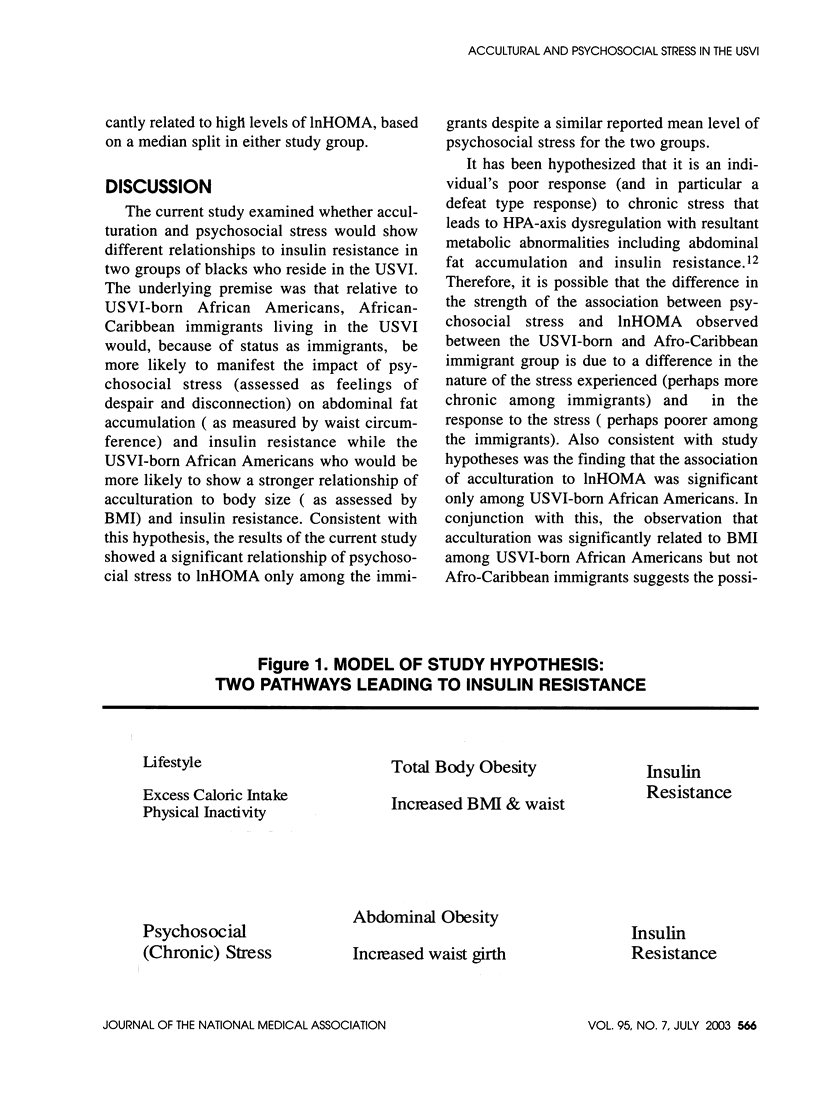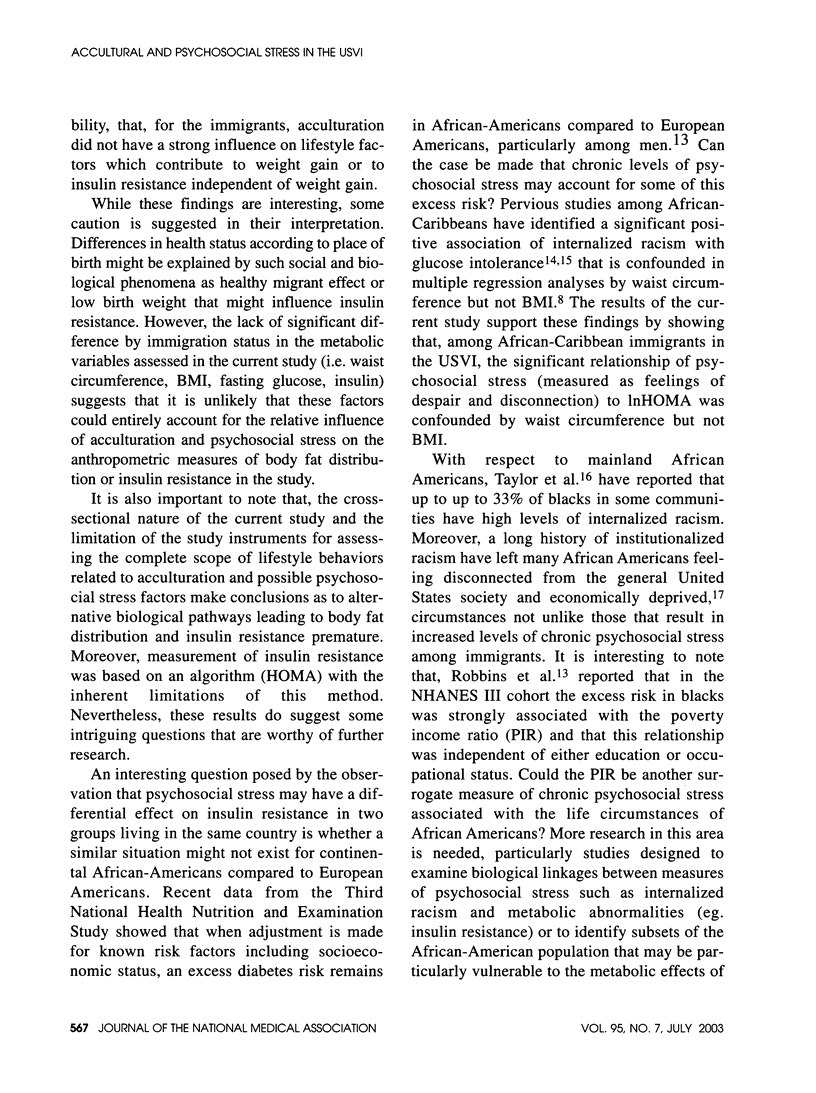Abstract
The objective of this study was to determine whether acculturation and psychosocial stress exert differential effects on body fat distribution and insulin resistance among native-born African Americans and African-Caribbean immigrants living in the US Virgin Islands (USVI). Data collected from a non-diabetic sample of 183 USVI-born African Americans and 296 African-Caribbean immigrants age > 20 on the island of St. Croix, USVI were studied. Information on demographic characteristics, acculturation and psychosocial stress was collected by questionnaire. Anthropometric measurements were taken, and serum glucose and insulin were measured from fasting blood samples. Insulin resistance was estimated by the homeostasis model assessment (HOMA) method. The results showed that in multivariate regression analyses, controlling for age, education, gender, BMI, waist circumference, family history of diabetes, smoking and alcohol consumption, acculturation was independently related to logarithm of HOMA (InHOMA) scores among USVI-born African Americans, but not among African-Caribbean immigrants. In contrast, among USVI-born African Americans psychosocial stress was not significantly related to InHOMA, while among African-Caribbean immigrants psychosocial stress was independently related to InHOMA in models that included BMI, but not in those which included waist circumference. This study suggests that acculturation and psychosocial stress may have a differential effect on body fat distribution and insulin resistance among native-born and immigrant blacks living in the US Virgin Islands.
Full text
PDF









Selected References
These references are in PubMed. This may not be the complete list of references from this article.
- Barlow K. M., Taylor D. M., Lambert W. E. Ethnicity in America and feeling "American". J Psychol. 2000 Nov;134(6):581–600. doi: 10.1080/00223980009598238. [DOI] [PubMed] [Google Scholar]
- Bermúdez O. I., Falcón L. M., Tucker K. L. Intake and food sources of macronutrients among older Hispanic adults: association with ethnicity, acculturation, and length of residence in the United States. J Am Diet Assoc. 2000 Jun;100(6):665–673. doi: 10.1016/s0002-8223(00)00195-4. [DOI] [PubMed] [Google Scholar]
- Björntorp P. Do stress reactions cause abdominal obesity and comorbidities? Obes Rev. 2001 May;2(2):73–86. doi: 10.1046/j.1467-789x.2001.00027.x. [DOI] [PubMed] [Google Scholar]
- Björntorp P., Rosmond R. Neuroendocrine abnormalities in visceral obesity. Int J Obes Relat Metab Disord. 2000 Jun;24 (Suppl 2):S80–S85. doi: 10.1038/sj.ijo.0801285. [DOI] [PubMed] [Google Scholar]
- Butler Cleve, Tull Eugene S., Chambers Earle C., Taylor Jerome. Internalized racism, body fat distribution, and abnormal fasting glucose among African-Caribbean women in Dominica, West Indies. J Natl Med Assoc. 2002 Mar;94(3):143–148. [PMC free article] [PubMed] [Google Scholar]
- French S. A., Harnack L., Jeffery R. W. Fast food restaurant use among women in the Pound of Prevention study: dietary, behavioral and demographic correlates. Int J Obes Relat Metab Disord. 2000 Oct;24(10):1353–1359. doi: 10.1038/sj.ijo.0801429. [DOI] [PubMed] [Google Scholar]
- Fung T. T., Hu F. B., Yu J., Chu N. F., Spiegelman D., Tofler G. H., Willett W. C., Rimm E. B. Leisure-time physical activity, television watching, and plasma biomarkers of obesity and cardiovascular disease risk. Am J Epidemiol. 2000 Dec 15;152(12):1171–1178. doi: 10.1093/aje/152.12.1171. [DOI] [PubMed] [Google Scholar]
- Harding A. H., Williams D. E., Hennings S. H., Mitchell J., Wareham N. J. Is the association between dietary fat intake and insulin resistance modified by physical activity? Metabolism. 2001 Oct;50(10):1186–1192. doi: 10.1053/meta.2001.26702. [DOI] [PubMed] [Google Scholar]
- Hovey J. D. Psychosocial predictors of acculturative stress in Mexican immigrants. J Psychol. 2000 Sep;134(5):490–502. doi: 10.1080/00223980009598231. [DOI] [PubMed] [Google Scholar]
- Knowler William C., Barrett-Connor Elizabeth, Fowler Sarah E., Hamman Richard F., Lachin John M., Walker Elizabeth A., Nathan David M., Diabetes Prevention Program Research Group Reduction in the incidence of type 2 diabetes with lifestyle intervention or metformin. N Engl J Med. 2002 Feb 7;346(6):393–403. doi: 10.1056/NEJMoa012512. [DOI] [PMC free article] [PubMed] [Google Scholar]
- Kriska A. M., Hanley A. J., Harris S. B., Zinman B. Physical activity, physical fitness, and insulin and glucose concentrations in an isolated Native Canadian population experiencing rapid lifestyle change. Diabetes Care. 2001 Oct;24(10):1787–1792. doi: 10.2337/diacare.24.10.1787. [DOI] [PubMed] [Google Scholar]
- Matthews D. R., Hosker J. P., Rudenski A. S., Naylor B. A., Treacher D. F., Turner R. C. Homeostasis model assessment: insulin resistance and beta-cell function from fasting plasma glucose and insulin concentrations in man. Diabetologia. 1985 Jul;28(7):412–419. doi: 10.1007/BF00280883. [DOI] [PubMed] [Google Scholar]
- Robbins J. M., Vaccarino V., Zhang H., Kasl S. V. Excess type 2 diabetes in African-American women and men aged 40-74 and socioeconomic status: evidence from the Third National Health and Nutrition Examination Survey. J Epidemiol Community Health. 2000 Nov;54(11):839–845. doi: 10.1136/jech.54.11.839. [DOI] [PMC free article] [PubMed] [Google Scholar]
- Satia-Abouta Jessie, Patterson Ruth E., Kristal Alan R., Teh Chong, Tu Shin-Ping. Psychosocial predictors of diet and acculturation in Chinese American and Chinese Canadian women. Ethn Health. 2002 Feb;7(1):21–39. doi: 10.1080/13557850220146975. [DOI] [PubMed] [Google Scholar]
- Satia J. A., Patterson R. E., Kristal A. R., Hislop T. G., Yasui Y., Taylor V. M. Development of scales to measure dietary acculturation among Chinese-Americans and Chinese-Canadians. J Am Diet Assoc. 2001 May;101(5):548–553. doi: 10.1016/S0002-8223(01)00137-7. [DOI] [PubMed] [Google Scholar]
- Tull E. S., Chambers E. C. Internalized racism is associated with glucose intolerance among Black Americans in the U.S. Virgin Islands. Diabetes Care. 2001 Aug;24(8):1498–1498. doi: 10.2337/diacare.24.8.1498. [DOI] [PubMed] [Google Scholar]
- Tull Eugene S., Ambrose John J., Chambers Earle. A preliminary assessment of acculturation and its relationship to body size and glucose intolerance among Blacks in the US Virgin Islands. Ethn Dis. 2003 Winter;13(1):15–21. [PubMed] [Google Scholar]
- Tull Eugene S., LaPorte Ronald, Kriska Andrea, Mark Joseph, Hatcher Ann T. Glucose intolerance by race and ethnicity in the U.S. Virgin Islands. J Natl Med Assoc. 2002 Mar;94(3):135–142. [PMC free article] [PubMed] [Google Scholar]
- Vioque J., Torres A., Quiles J. Time spent watching television, sleep duration and obesity in adults living in Valencia, Spain. Int J Obes Relat Metab Disord. 2000 Dec;24(12):1683–1688. doi: 10.1038/sj.ijo.0801434. [DOI] [PubMed] [Google Scholar]


